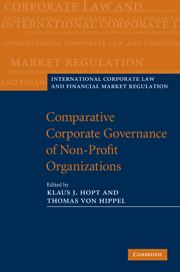Book contents
- Frontmatter
- Contents
- List of contributors
- Preface
- Abbreviations
- PART I Economic findings and theories on nonprofit organizations
- PART II The nonprofit sector: private law, trust law, tax law in selected countries
- 4 Anglo-American countries
- 5 Germanic countries
- 5.1 Nonprofit organizations in Germany
- 5.2 Nonprofit organizations in the Netherlands
- 6 Romanic countries
- 7 Transformation countries
- PART III The board of nonprofit organizations
- PART IV Good governance of nonprofit organizations: activities and regulatory problems
- PART V Good governance of nonprofit organizations: self-regulation, disclosure and supervision
- Index
- References
5.1 - Nonprofit organizations in Germany
from 5 - Germanic countries
Published online by Cambridge University Press: 05 August 2011
- Frontmatter
- Contents
- List of contributors
- Preface
- Abbreviations
- PART I Economic findings and theories on nonprofit organizations
- PART II The nonprofit sector: private law, trust law, tax law in selected countries
- 4 Anglo-American countries
- 5 Germanic countries
- 5.1 Nonprofit organizations in Germany
- 5.2 Nonprofit organizations in the Netherlands
- 6 Romanic countries
- 7 Transformation countries
- PART III The board of nonprofit organizations
- PART IV Good governance of nonprofit organizations: activities and regulatory problems
- PART V Good governance of nonprofit organizations: self-regulation, disclosure and supervision
- Index
- References
Summary
Introduction
The term “nonprofit organizations”
In Germany the term “nonprofit organizations” is not legally defined, but it is often used in various fields of science (e.g. sociology, economics, political science, and sometimes also law). Although the definitions differ in detail, there is one common finding: nonprofit organizations are subject to a non-distribution constraint, which means that such an organization is barred from distributing its net earnings, if any, to individuals who exercise control over it, such as members, officers, directors or trustees.
Empirical information
At the moment there are around 600,000 associations and 15,000 foundations in Germany. The number of unincorporated associations and foundations without legal personality is unknown. The same is true for the number of tax-exempt organizations and charitable limited liability companies.
Institutional law
In Germany there are two basic forms of legal persons for nonprofit organizations: associations (Vereine) and foundations (Stiftungen). Both legal forms are regulated in the German Civil Code (§§ 21 et seq. for associations and §§ 80 et seq. for foundations). As regards foundations, there are additional laws in the sixteen German provinces (Länder) that mainly include provisions for state supervision.
The basic difference between an association and a foundation is that while an association must have members, a foundation must not have members. This is the distinction between these two legal forms (cf. the traditional separation under Roman law between universitas personae and universitas bonorum).
- Type
- Chapter
- Information
- Comparative Corporate Governance of Non-Profit Organizations , pp. 197 - 227Publisher: Cambridge University PressPrint publication year: 2010
References
- 9
- Cited by



